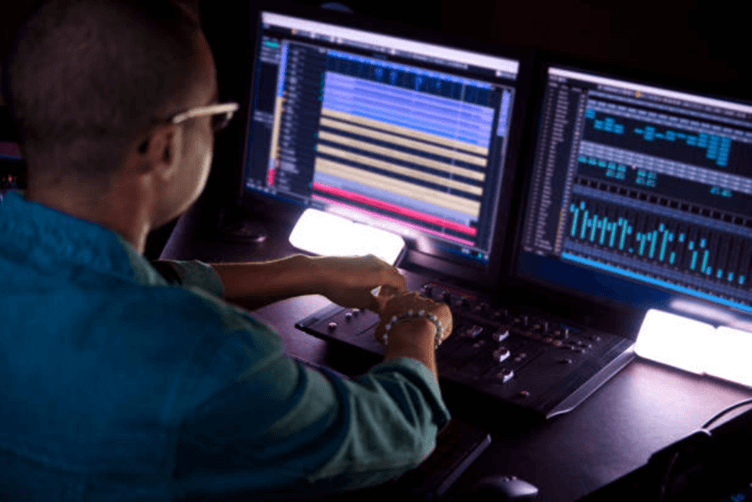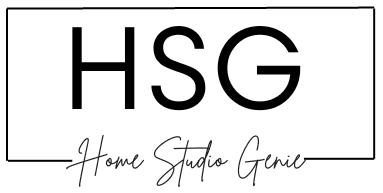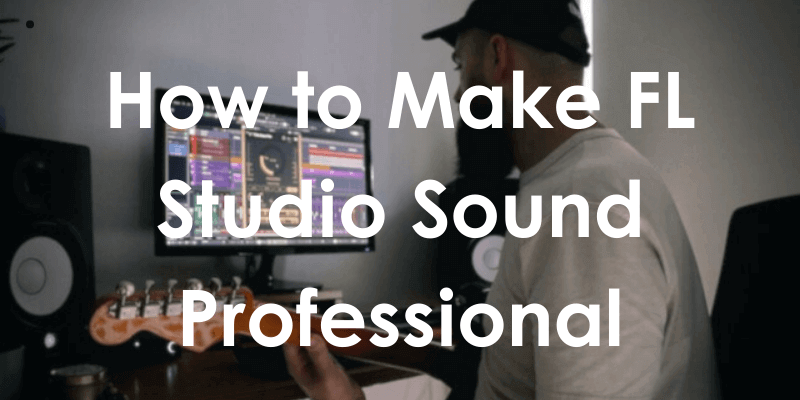Back when I was a beginner using FL Studio, I often wondered why my mixes sounded amateur. Comparing my music to what I hear on the radio left me frustrated and disappointed.
After trying out a host of techniques and tricks the pros use, I could tell that my FL Studio mixes were improving. As I read more about mixing and mastering, it all began falling into place.
In this article, we’re delving deeper into making FL Studio tracks that sound more professional and polished.
Let’s jump in and find out.
1. Making your FL Studio Songs Sound Professional In FL Studio
In this guide, I’ll show you how to make FL Studio sound professional, even if you’re just starting out.
FL Studio is a powerful digital audio workstation that can help you create amazing music right from your computer.
The journey from amateur to a novice is no easy feat when it comes to FL Studio productions. You’ll often find yourself frustrated at your final mixes and wonder what the problem is.
Practice will eventually make perfect when you get to hear your polished mixes compared to your beginner ones. Perseverance will eventually be your best friend, as long as you make sure to enjoy the journey.
Professional music you hear on the radio had tons of people working from creation to finish. They likely had a whole team working on the track.
On the other hand, you’re likely alone with your laptop and a few basic pieces of audio hardware. You need to be patient with yourself while learning as much as you can about how the professionals do it.
With that said, let’s get into the steps to get you to professional-grade tracks in no time.
2. Setting Up FL Studio the right way

Choosing the Right FL Studio Version
To get started, you’ll need to choose the right version of FL Studio for your productions. There are different editions available, ranging from the free trial version to the fully-featured Producer Edition.
If you’re serious about making professional-sounding music, investing in the Producer Edition or higher is worth considering.
This version has a lot more plugins and effects that you’re going to need. Lower versions often limit features and plugins.
Check out the latest price on Amazon

Key differences between the different FL Studio versions:
| Feature | Fruity Edition | Producer Edition | Signature Bundle |
| Piano roll pattern editor | Yes | Yes | Yes |
| Playlist | Yes | Yes | Yes |
| Audio recording | No | Yes | Yes |
| Audio editing | No | Yes | Yes |
| Mixing | No | Yes | Yes |
| Plugins | Basic synths and effects | Additional synths and effects | Additional synths, effects, and tools |
| Price | $99 | $199 | $299 |
See also: Problems With Ableton Live? 6 Common Issues (Solved)
Installing and Configuring FL Studio
Once you’ve chosen your version, it’s time to install and configure FL Studio. Simply follow the instructions provided by the software and make sure everything is set up correctly.

This will ensure a smooth workflow and optimal performance. If you come across issues, check out our article on the common problems with FL Studio.
The installation process is straightforward and should take less than 15 minutes to complete. Make sure you have enough space on your hard drive for the full installation package from Image-Line.
Familiarize Yourself with the Interface
If you’re just starting out, FL Studio might seem overwhelming at first, but don’t worry! Take your time to explore the interface and get familiar with the different features and tools.
Understanding how everything works will make it easier for you to create professional-sounding music. FL Studio has a great interface that is both intuitive and user-friendly.
It can take you around three to eight weeks to learn FL Studio and become proficient enough to use it. If you come from another DAW such as Ableton Live, Logic Pro, or Cubase, the learning time might be shorter.
3. Get Started with Quality Sounds
Using High-Quality Samples
As the age-old saying goes,” What you put in is what you get out”. This rings true in the music production scene.
Using quality samples to start your productions makes sure that the final product will sound professional. This is also because the samples you start with will likely go through rigorous editing and mixing.
Samples are pre-recorded sounds that you can use in your music. Using high-quality samples can make a huge difference in the overall sound of your tracks.
Look for sample packs from reputable sources. You can even record your own sounds to add a personal touch to your music.
If you’re making EDM for example, you can place a lot of emphasis on choosing the right kick-drum, snare, and hi-hats.
This is because, in genres like dance, the beat drives most of the track. It’ll also be the basis on which other synths, melodies, and hooks are based.
Understanding Sound Selection
When choosing sounds for your tracks, it’s important to consider their quality and how well they fit together. Using presets from your favorite VST or recording your own sounds can help.
Experiment with different combinations and listen carefully to how they sound. Remember, the right sounds can make your music stand out.
FL Studio has a wide range of instrument VSTs to use for the sounds you need. There are also stock sound kits that come with FL Studio.
The sounds you choose will also depend on the genre of music you’re going for. For example, jazz tracks use organic sounds and instruments. Whereas EDM on the other hand has a lot of artificial synth sounds.
Give a good listen to the biggest tracks in your genre and try to figure out what sort of sounds the professionals use.
4. Mastering the Mixer
Balancing Your Tracks
The mixer in FL Studio is like a control panel that helps you balance the different elements of your track. Think of it as a genie that ensures each sound gets its time to shine.

Adjust the volume levels of each track so that they work together harmoniously. You don’t want one sound to overpower the others or get lost in the mix.
The mixer also helps balance the individual tracks sonic spectrum, so that each sound sits well in the mix. If a synth is too loud, or the bassline is too low, you can control them from the mixer.
Apply Effects and Equalization
Once you’ve balanced the tracks, it’s time to add some extra magic with effects and equalization. Effects can transform your dull sounds to make them shine.
Equalization helps you adjust the frequencies of each sound. It’s like a superhero costume tailor-made for each track, making sure they sound just right.
For example, with equalization, you can cut out the lows from all mids and highs so that the bassline pops. Similarly, the high components such as high hats and strings can also be equalized.
You can your sounds bigger, add echoes, or even make them sound like they’re underwater. It’s important to pay attention to the sort of effects used in professional tracks in your genre.
Many professional producers swear by reverb plugins, compression, EQ, and filters. It’s always a good idea to experiment with different effect plugins to change the original sample so that it fits into the mix.
See also: Are FL Studio Stock Plugins Good Enough? (8 Things To Remember)
5. Arranging Your Music
The music arrangement is an integral part of the overall mix because it takes the listener on a journey. Arrangement in FL Studio is when you put together several different parts of the track together in the timeline.
For example, EDM music almost always starts with a beat before introducing other elements such as vocals and synth melodies.
Creating Catchy Melodies
Now it’s time to let your creativity flow and create some catchy melodies. Melodies are like theme songs—they stick in your head and make you want to dance.
If you have some music theory knowledge, FL Studio will help you create catchy melodies easily. Chord progressions and melodies are as easy as clicking and dragging into the editor.
You might need a midi keyboard to experiment with the melody until you get the right one for the song.
FL Studio has an intuitive tool to help you stay in key when making melodies and chord progression. This is great for beginners with little to no more music theory training.
Experiment with different notes and rhythms until you find a melody that works well with other components in the track.
Remember, there are no wrong notes, only new possibilities.
Layering Sounds for Depth
To make your music sound even more professional, try layering different sounds together. Imagine you’re building a tower of blocks, each representing a different sound.
By stacking these sounds on top of each other, you create a sense of depth and richness.
For example, you can add a synth lead on top of the notes you use for your melody. This can also work well by adding a higher-pitched sound together with your bassline.
Stacking your sounds like this adds variety to your tracks and a more vibrant atmosphere.
Speaking of atmosphere, adding more reverb and panning different sounds to the left or right works wonders. The listener is taken on a journey and the track feels more rounded and professional.
6. Adding Professional Touches
Using Automation
Automation is like giving your music superpowers! It allows you to control different aspects of your sounds over time.
For example, you can make a sound gradually fade in or out, change its pitch, or add some cool effects at specific moments. This adds variety and keeps listeners engaged for the duration of the song.
Automation adds dynamic and expressive elements to your music. This makes your overall track sound more professional and captivating.
You can often hear a lot of automation on the pitch of synth leads in EDM music. It builds up anticipation to the breakdown of the track which then gives a sense of satisfaction for the listener.
Final Effects and Transitions
Just like superheroes have flashy special effects in their movies, your music can benefit from some effects and transitions too.
Use effects like risers, swooshes, or filters to add excitement and anticipation to your tracks.
This s when you introduce elements such as the vocals, bassline, or different melodies
Transitions in your track help you smoothly move between different sections of your music, like scenes in a movie. They make your music flow seamlessly and keep your listeners hooked.
They also prevent melodies and other elements from stopping abruptly in the middle of the track. Listeners can anticipate that there is a transition coming up in the track. See also: Is FL Studio Used In Professional Studios?
7. Polishing Your Tracks
Mixing and Mastering
Once you’ve created your music, it’s time to give it that final polish. This adjusts the levels, panning, and spatial placement of each sound to create a balanced and immersive track.

Use the mixer’s panning controls to create a sense of space in your mix. Panning tracks to different sides of the stereo field will help them sound more distinct and separated.
Effects like reverb, delay, and distortion can be used to add interest and depth to your mix.
It’s like making sure all the superhero team members work together flawlessly. Mastering, on the other hand, adds the finishing touches by optimizing the overall sound quality.
Mastering also makes your tracks and overall production sound great on different devices. Play your track in your car, home stereo, phone, laptop, or a club audio system.
Your tracks will sound different in a variety of different environments and devices. You’re aiming for a more uniform sound from one device to the next.
Exporting and Sharing Your Music
Congratulations, you’ve now made your music sound professional! Now it’s time to share it with the world.
Export your tracks as high-quality audio files and share them on music-sharing platforms. You can use platforms like SoundCloud, YouTube, or even your friends and family.
You never know who might be inspired by your music or become your biggest fan!
8. Tips and Tricks from the Pros
Embracing Creativity
- Don’t be afraid to think outside the box and try new things.
- Embrace your creativity and let it guide you in making music that truly reflects who you are.
- Take breaks every once in a while to help you stay fresh and avoid getting fatigued.
- Use a good pair of headphones or monitors.
- Get feedback from others. This will help you catch any problems that you may have missed.
Continuously Learning and Experimenting
The journey of making professional-sounding music never ends. Keep learning new techniques, exploring different genres, and experimenting with your sound.
The more you explore and try new things, the more you’ll grow as a musician and develop your own unique style.
How To Continuously Learn And Experiment With Fl Studio:
- Experiment with different plugins and effects
- Set aside time each day or week to practice
- Watch videos of other producers working
- Get feedback from other producers
- Take online courses or tutorials
- Don’t be afraid to make mistakes
Conclusion
By following these simple steps, you can transform your musical creations into something truly amazing. You’ve learned the secrets of making FL Studio sound professional.
Remember, it’s all about balancing your tracks, using high-quality sounds, mastering the mixer, arranging your music creatively, and adding those professional touches.
Remember, you have the power to make FL Studio sound professional and create music that touches hearts and inspires others.
FAQs
How Long Does It Take To Make FL Studio Sound Professional?
It can take anywhere from three to nine weeks to learn FL Studio and become proficient enough to make professional tracks. With dedication and consistent effort, you’ll see improvement over time.
Do I Need Expensive Equipment To Achieve Professional-Sounding Music?
No, you don’t need expensive equipment and plugins to make professional music with FL Studio.FL Studio provides a wide range of tools and effects to help you achieve professional results even with basic equipment.
Can I Use Fl Studio To Make Different Genres Of Music?
Yes, FL Studio is a versatile software that allows you to create music in various genres, from electronic and hip-hop to rock and classical. The sky’s the limit!
Are There Any Shortcuts To Speed Up The Process?
You can save time by learning keyboard shortcuts and using templates or presets as a starting point. There are no shortcuts to becoming a master at music production. However, don’t forget to add your personal touch and make your music unique.
How Can I Find My Unique Sound In FL Studio?
Finding your unique sound takes time and experimentation. Explore different instruments, effects, and styles. Trust your instincts, follow your passion, and let your music reflect your true self.
Sources:
MusicRadar’s FL Studio tutorials
Sound on Sound’s FL Studio articles
Reddit’s r/FL_Studio community

Mike is a skilled musician, guitar technician, and music producer with a passion for audio and gear. He excels in teaching guitar, editing podcasts/videos, and creating captivating soundscapes using cutting-edge hardware, software, and plugins. Mike’s talent and commitment make him highly sought-after in the industry, inspiring fellow musicians worldwide.


